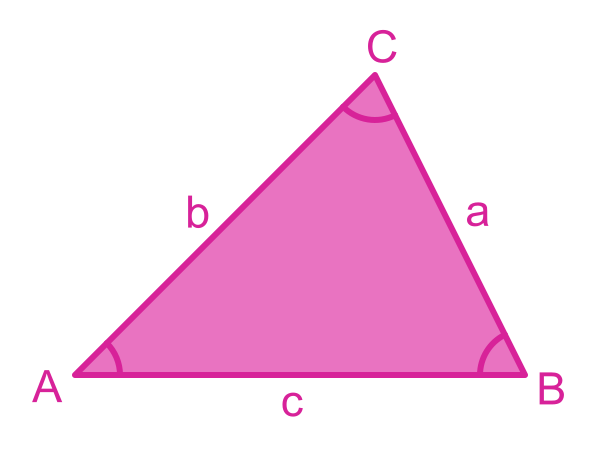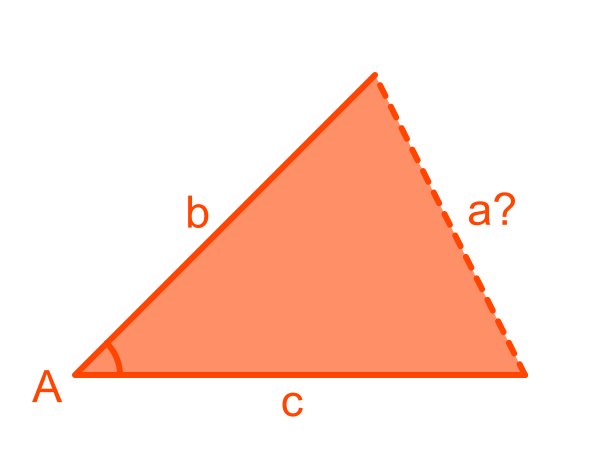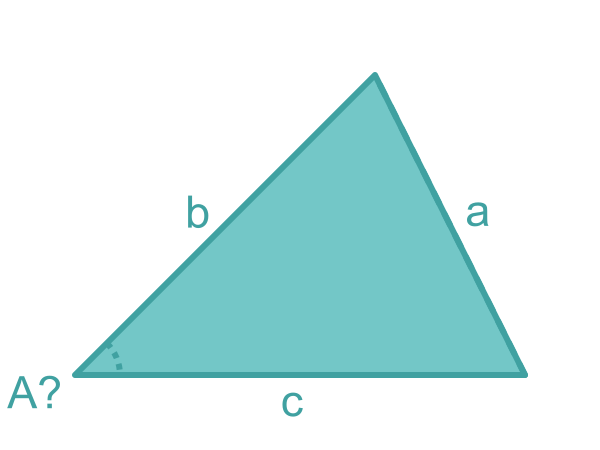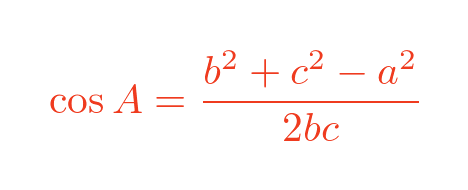Cosine rule
Categories: gcse trigonometry
Level:

The cosine rule is a trigonometry formula that relates the sides and angles of a triangle. It can be used to solve a triangle if we know either:
- Two sides of the triangle, and the angle enclosed between those sides.
- Three sides but none of the angles.
For other cases, you will need to use the sine rule.
The rule applies to any triangle, not just right-angled triangles.
Labelling the triangle
It is important to label the triangle correctly, otherwise the rule won't work! We name the angles A, B and C, and we name the sides a, b and c:

The important thing to remember is that each angle is opposite the side of the same name:
- Angle A is opposite side a.
- Angle B is opposite side b.
- Angle C is opposite side c.
The cosine rule
The cosine rule tells us that:

Finding a side using the cosine rule
In this example, we know the sides b and c, plus the enclosed angle A, and we wish to find the other side, a.

The cosine rule lets us find a squared, so to find a we need to take the square root of both sides. Here is the formula:

Finding an angle using the cosine rule
In this example we know the sides a, b and c, so we can find the angle, A:

The cosine rule can be rearranged to find the cosine of A. Here is the formula:

In both cases, we will know the value of one angle and all three sides. We can then use the sine rule to find the other angles.
Related articles
Join the GraphicMaths Newsletter
Sign up using this form to receive an email when new content is added to the graphpicmaths or pythoninformer websites:

Popular tags
adder adjacency matrix alu and gate angle answers area argand diagram binary maths cardioid cartesian equation chain rule chord circle cofactor combinations complex modulus complex numbers complex polygon complex power complex root cosh cosine cosine rule countable cpu cube decagon demorgans law derivative determinant diagonal directrix dodecagon e eigenvalue eigenvector ellipse equilateral triangle erf function euclid euler eulers formula eulers identity exercises exponent exponential exterior angle first principles flip-flop focus gabriels horn galileo gamma function gaussian distribution gradient graph hendecagon heptagon heron hexagon hilbert horizontal hyperbola hyperbolic function hyperbolic functions infinity integration integration by parts integration by substitution interior angle inverse function inverse hyperbolic function inverse matrix irrational irrational number irregular polygon isomorphic graph isosceles trapezium isosceles triangle kite koch curve l system lhopitals rule limit line integral locus logarithm maclaurin series major axis matrix matrix algebra mean minor axis n choose r nand gate net newton raphson method nonagon nor gate normal normal distribution not gate octagon or gate parabola parallelogram parametric equation pentagon perimeter permutation matrix permutations pi pi function polar coordinates polynomial power probability probability distribution product rule proof pythagoras proof quadrilateral questions quotient rule radians radius rectangle regular polygon rhombus root sech segment set set-reset flip-flop simpsons rule sine sine rule sinh slope sloping lines solving equations solving triangles square square root squeeze theorem standard curves standard deviation star polygon statistics straight line graphs surface of revolution symmetry tangent tanh transformation transformations translation trapezium triangle turtle graphics uncountable variance vertical volume volume of revolution xnor gate xor gate
